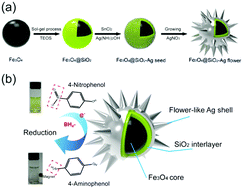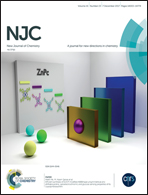Silver coated magnetic microflowers as efficient and recyclable catalysts for catalytic reduction†
Abstract
This study proposes an effective route for synthesis of three-dimensional (3D) flower-like, Ag-coated magnetic (Fe3O4@SiO2@Ag) microcomposites with well-controlled sizes and shapes. The fabricated microflowers consist of a micro-scale Fe3O4@SiO2 core, which provides sufficient magnetic response properties and good dispersibility, and a highly-branched Ag shell, which is characterized by a large specific surface area and multidimensional catalytically active sites. The Ag seeds on the Fe3O4@SiO2 microspheres play a key role in the formation of a flower-like structure and can be produced massively and reproducibly through electroless plating. Furthermore, the surface morphologies of the microcomposites can be well controlled by changing the experimental parameters. Four kinds of composites with well-tuned surface morphologies were synthesized to systematically investigate the effect of surface nanostructures on the performance of catalytic reduction reactions. Highly-branched microflowers exhibit significantly higher catalytic activity than non-branched or little-branched structures toward the reduction of 4-nitrophenol and methylene blue. The flower-like catalysts, which exhibit excellent magnetic properties, can be easily recycled and retain >93% conversion for at least six cycles. Hence, Fe3O4@SiO2@Ag microflowers can be efficient and recyclable catalysts for various catalytic reductions.



 Please wait while we load your content...
Please wait while we load your content...